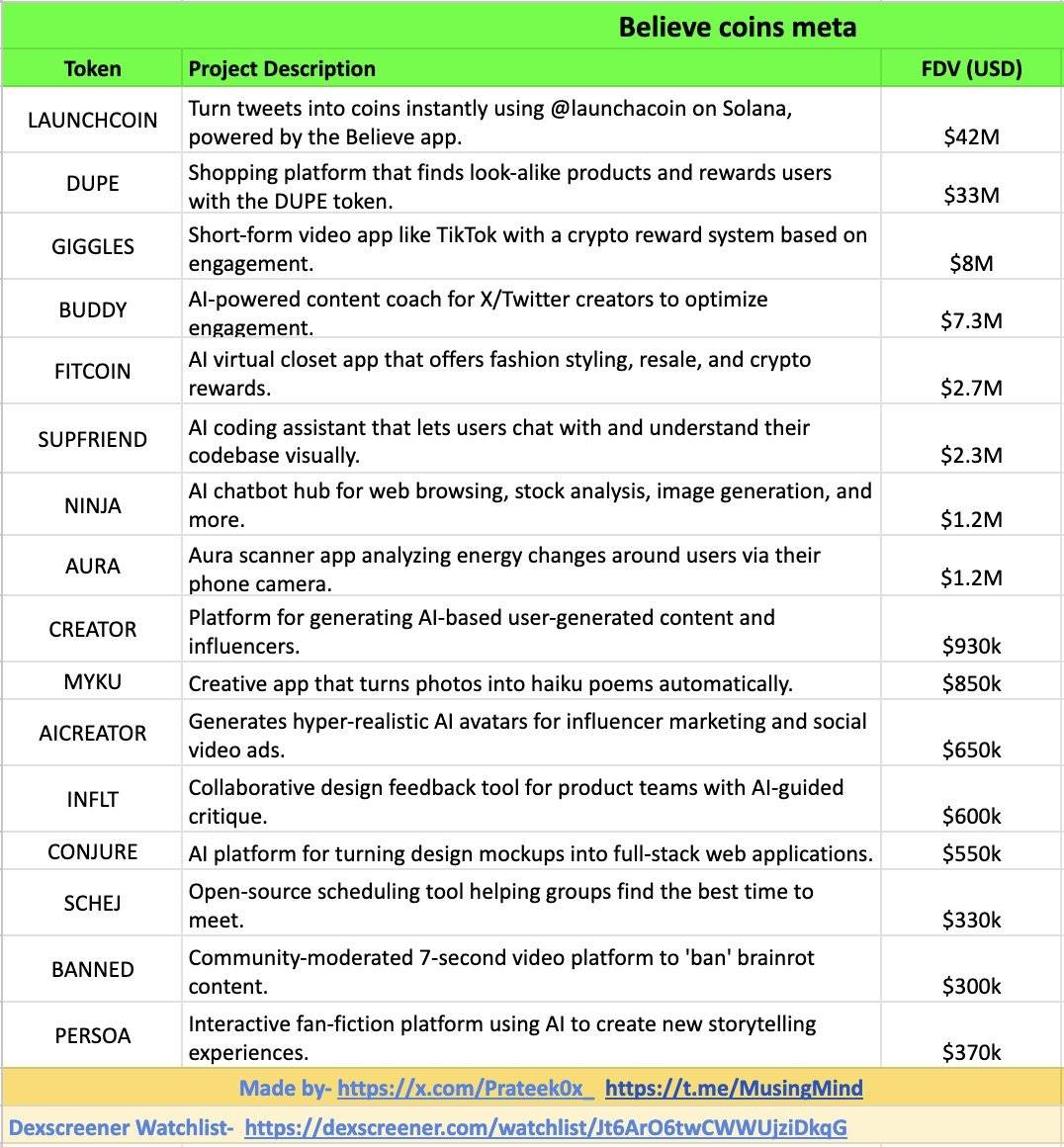撰文:Choze, 加密 KOL
编译:Felix, PANews
一种新的模式正在兴起:喧闹、快速且充满投机性。它被称为互联网资本市场(ICM),有人认为这是加密领域最令人兴奋的发展,也有人认为这是最危险的干扰。
2025 年,一波独立开发者开始直接在 X(没错,就是这里)上为互联网原生应用发行可交易代币,借助诸如 Launchcoin 和 Believe 这样的工具。结果如何?一个无需许可的市场应运而生,在这里,创意变成代币,炒作变成资本,投机变成产品吸引力。
ICM 正引起人们的关注,但更大的问题不是它能否走红,而是这种模式是否可持续。
什么是 ICM?
ICM 是一种去中心化的平台,资本直接流向应用开发者和创作者。没有风投,没有银行,也没有应用商店。其模糊了众筹、代币发行和股权投机之间的界限。
开发者发布一个想法。公众通过代币参与。交易量增长,费用累积,开发者获利。如果足够多的人相信,代币就会暴涨。如果不行,它就会消亡。这就是 Believe 和 Launchcoin 等平台背后的核心机制。
支持者认为 ICM 使创新民主化。批评人士则认为,它们将虚拟的产品金融化。或许两者都有道理。
看多论:先投机,后建设
支持 ICM 的最有力论据可以归结为四个方面:
-
无需许可的创意融资:任何能上网的人都可以支持构建者。无需风险投资会议,无需守门人。
-
利益一致的收入:建设者赚取 50% 的交易费用,这为他们提供了直接的资金来启动产品。
-
无摩擦的病毒式传播:通过将代币发行与 X 帖子绑定,分发速度与 meme 币动态相匹配。
-
文化解锁:ICM 顺应「氛围编程」(PANews 注:Vibe Coding,一种使用 AI 辅助的编程范式)的潮流。独立开发者、独立创作者和小众创始人利用散户资本从零到一。
这个飞轮获得了巨大的发展势头:
-
$DUPE 市值在几天内飙升至 3800 万美元
-
$BUDDY 通过 AI 创作工具实现了 30 万美元的 ARR(年度经常性收入)
-
$FITCOIN 的下载量达到 30 万次,曝光量达数百万次
这种宣传语极具吸引力:立即为创意提供资金,利用炒作,然后依靠社区信念来打造产品。

来源:@Prateek0x_
看衰论:代币化噪音
但表象之下潜藏着深层次的结构性风险:
-
产品与市场契合度不足:许多 ICM 代币在推出时没有任何功能或需求证明,仅仅只是一些噱头和梗而已。
-
投机胜过实质:散户投资者基于炒作周期而非业务基本面进行购买代币。
-
短期主义:由于建设者能立即赚取交易费用,维持长期价值的动力有限。
-
缺乏法律保障:大多数 ICM 代币并非股权,也不受监管,无法保证可问责性。
-
用户粘性低:代币可能迅速上涨,但同样可能迅速下跌。用户与平台的利益一致性难以保证。
个人认为,这种趋势有可能裹挟「ICM」这一标签,削弱其最初关于链上 IPO 和流动性数字股权的承诺,将其变成一个充斥着「拉高出货」式 meme 币的投机场所。
即使在活跃的交易者中,许多人也坦率承认他们的意图只是快速获利,这表明即使是所谓的信徒也在玩短线游戏。
Believe:基础设施还是助推者?
ICM 生态的核心是 Believe 生态系统,它能让任何人几秒钟内就发行代币。流程很简单:
-
推文发布代币($TICKER + 名称)
-
立即生成 Bonding Curve(联合曲线)和流动性池
-
赚取所有交易费用的 50%
-
一旦代币达到市值门槛(10 万美元),即可获得更深的流动性
构建者无需像传统方式那样筹集资金。但问题就在这里。
当在产品出现之前就预先赚取收益时,构建者和投机者之间的界限变得模糊。
虽然像 $DUPE 和 $GIGGLES 这样的项目显示出一些吸引力,但其他项目感觉更像是 meme。基础设施令人印象深刻,但工具不能实现目的。
两种愿景的故事
关于 ICM,人们对其看法出现了根本性的分歧:
-
理想主义者认为:ICM 是 Web3 的最终形态。链上 IPO、去中心化股权以及为互联网原生公司提供透明且始终开放的金融层。
-
现实主义者认为:它只是代币化最小可行产品(MVP)的投机乐园,没有路线图、没有护城河,也没有问责机制。
两种说法都在流传。根据哪一方构建者发展势头强劲,其中一方可能会取代另一方。
前景与陷阱
不可否认,ICM 触及了一些现实因素:早期支持创意的渴望、融资文化的乐趣,以及对未来可能火爆的事物进行投机的本能。
但这种同样的便捷性也带来了稀释的风险。如果没有纪律或长期的协同,ICM 有可能沦为另一个「拉高出货」的场所。在这种情况下,meme 币披上了生产力的外衣,流动性掩盖了实质性的缺乏。
虽然一些参与者将 ICM 视为初创企业融资的未来,但也有一些参与者将其纯粹视为盈利工具。这种二元性使得很难区分信号和噪音。
未来发展方向
要使 ICM 超越炒作周期走向成熟,需要做到以下几点:
-
持久的建设者:项目需要交付并留住用户,而不仅仅是快速融资。产品与市场契合的团队必须发挥引领作用。
-
可信的指标:屏幕和仪表板应突出实际采用情况,而不仅是交易量或波动性。
-
渐进式监管:如果代币化的初创企业想要获得价值回报,它们最终可能需要融合实用性和合规性的法律框架。
-
叙事原则:并非所有可交易的理念都是「ICM」。该术语必须保留其内涵才能具有长期价值。
ICM 并非敌人,但目前也并非解决方案。它们就像一块画布,最终结果取决于在上面绘制的内容。
虽是新的概念,但其运作机制却并不陌生。关键在于,这能否演变成具有结构性意义的事物,还是像之前的许多加密热潮一样逐渐消退。时间和发展趋势将给出答案。
免责声明:本文章仅代表作者个人观点,不代表本平台的立场和观点。本文章仅供信息分享,不构成对任何人的任何投资建议。用户与作者之间的任何争议,与本平台无关。如网页中刊载的文章或图片涉及侵权,请提供相关的权利证明和身份证明发送邮件到support@aicoin.com,本平台相关工作人员将会进行核查。




